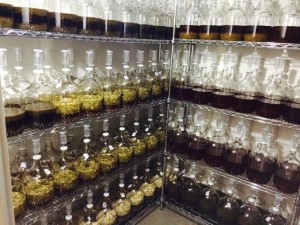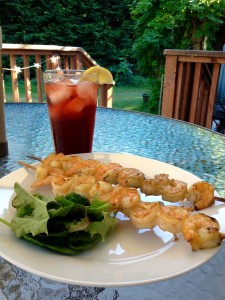
By Nikki McCoy

My husband drizzles Salish Sea’s Lemongrass Liqueur over prawn skewers while I stir the iced tea, making sure to top it with a lemon wedge and Salish Sea’s Hibiscus Liqueur.
Based on the recommendation of Sandy Desner, general manager of Salish Sea Organic Liqueurs, we are prepping our first culinary creations using local, organic liqueurs.
We’ve tasted the Lemongrass Liqueur in pure form – a fragrant, soft sipper – but we can’t wait to try it on food, its flavor enhanced by the heat.
“It makes the best barbequed prawns you will ever taste,” promises Sandy. “What we do is pour a little bit of liqueur in the bottom of a pan, place the prawns in there for 30 minutes, flip them once and pop them on the barbeque.”
Salish Sea currently has 17 flavors in stock, with Ameretto, Grapefruit, Limoncello, Nectarine and Vanilla on their way – all worthy of being served straight, mixed, or surprisingly, in your food.
“Experimentation is the fun part. If I could get away with it, I’d have 200 flavors,” laughs Sam Desner, Sandy’s son and head distiller.
The integrity of the flavor comes from Sam’s distinct process for making his liqueurs.

A lot of liqueurs are made using distillation, whereas Sam is using a process called cold maceration. Typically made in stills, many liqueurs are made using extracts and artificial flavors. If herbs or fruits are used, they are put in an infusion bag inside the still. But Salish Sea’s product actually ages with the herb or flower in it, while cutting out the distillation step – the difference is smoothness and balance of flavors.
Sam explains that each small batch undergoes multiple infusions over the course of a month, made one gallon at a time – with only real herbs and flowers. While soaking in alcohol and on a strict stirring regimen, simple syrup (purified water and pure organic cane sugar) is then boiled to a specific consistency and temperature, and added. More stirring, then the mix is strained, tested, blended, filtered and bottled. You might think this process sounds like a rather simple process but each batch can have upwards of fifty steps from start to completion. Because of this process, many of the liqueurs take on a tea-like quality.
And while most people associate liqueurs with livening up cocktails (check out Salish Sea’s awesome cocktail recipes – like Moscow Mule with Ginger Liqueur – here), they can be a wonderful addition in the kitchen, especially using savory flavors.
Salish Sea produces an assortment of savory liqueurs, which actually work great in a martini, but shine as a marinade for meats.

Sandy and Sam love using the Sage and Rosemary liqueurs on chicken, noting how the cooking process caramelizes the sugar, locking in the herbal flavor.
“I think the flavor strength that you get is actually stronger in cooking with a liqueur than it would be if you used the fresh herb, and certainly more than a dried herb,” says Sandy. “We’ll marinate a whole chicken overnight, and then take the carcass and make soup stock out of it. It’s amazing how much of the flavor stays.”
Of course, cooking with liqueurs isn’t just for main dishes. The Desner’s suggest using the Hibiscus Liqueur (a top seller) in lemonade or iced tea, or as a topping on favorite ice creams or dessert. The same can be said for the Lavender, Rose Petal, Honeysuckle and more. Cinnamon and Peppermint are also after-dinner family favorites.
Sandy says variety is what appeals most to people, with many choosing their liqueurs based on smells and flavors associated with fond memories.
“Sam does a honeysuckle liqueur, and it’s based upon him as a kid, eating off a honeysuckle bush in our yard,” he explains. “And when people taste it, they’re like, ‘Wow, this tastes like I just picked a honeysuckle.’ That’s really what Sam was after – to capture the essence of an individual herb or flower in a way that, for people who love that herb or flower, it will really resonate with them.”
Salish Sea Organic Liqueurs invites you to taste for yourself. Tasting room hours are 12:00 – 6:00 p.m. Wednesday through Saturday and 12:00 – 4:00 p.m. on Sunday.
Tastings are $4.99/person, groups of five or more are $3.99/person, groups of 10 or more are $2.99/person. Bottles range in price, beginning in the low $30s for a fifth, and high teens to low $20s for pints. The tasting fee is waived with any purchase.
In Olympia, find Salish Sea’s products at Cryptatropa Bar, Le Voyeur Café and Lounge and Ralph’s Thriftway.
Hibiscus Liqueur Lemonade is a featured part of Harlequin Productions’ summer program, and theater-goers are encouraged to bring ticket stubs back to the tasting room for 5% off entire purchase.
For more deals and tasting room updates, follow Salish Sea Organic Liqueurs on Facebook.




















































